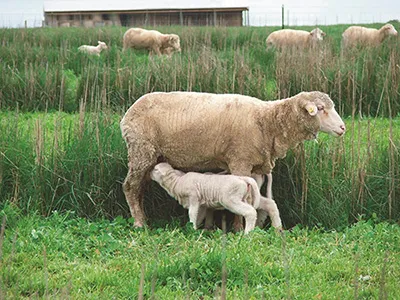By Colin Trengove, Pro Ag Consulting
Those ewes fortunate enough to lamb onto green feed have a great head start to optimising both ewe and lamb survival and lamb numbers as well as capitalising on the current unsurpassed ewe and lamb value.
Joining from January onwards promotes optimal twinning rates in Merinos while fecundity in other breeds improves with joining after January. It also results in lambing after the season break in most years giving ewes and lambs the best chance of survival.
Green feed is always at least 10 times cheaper than grain or hay (or closer to 20 times this year) and so it makes “cents” to lamb when it is available.
Peak energy needs are reached three weeks after lambing and  these
needs are ideally met by having sufficient quality green feed on offer as well as relying partially on ewe condition (fat reserves). Ewes need to be
around condition score 3 at lambing to optimise ewe and lamb survival at birth as well as supporting milk production during lactation. Failure to ensure
the ewes are in adequate condition in the lead up to birth predisposes to pregnancy toxaemia or “controlled starvation” - especially in twin or triplet
bearing ewes.
these
needs are ideally met by having sufficient quality green feed on offer as well as relying partially on ewe condition (fat reserves). Ewes need to be
around condition score 3 at lambing to optimise ewe and lamb survival at birth as well as supporting milk production during lactation. Failure to ensure
the ewes are in adequate condition in the lead up to birth predisposes to pregnancy toxaemia or “controlled starvation” - especially in twin or triplet
bearing ewes.
Choice of lambing paddock is fundamental to lamb survival. Features of a good lambing paddock include low predator risk, sufficient shelter to minimise wind speed at lamb height, avoiding damp cold southern slopes, and sufficient quality feed on offer. Shelter can be creeks, gullies, trees, shrubs, rushes or even dense clumps of stubble or perennial grasses to protect lambs from wind and rain.
Lamb birth weight is critical to survival at birth and standing to suckle the essential 100+ mL of colostrum in the first hour of life. Ideally twins are at least 4 kg at birth to optimise survival, while singles should not exceed 5.5 kg to minimise the risk of dystocia (difficult birth). Thereafter, green feed drives milk quality and production as well as mothering behaviour to optimise the chance of lamb survival. A benchmark is ensuring 1,500 kg of dry matter on offer per hectare which equates to a dense green pasture averaging 5 cm in height. The type of green feed is not critical provided it is not toxic or unpalatable. If adequate feed on offer is not, supplementary feeding will be required.
Lambs begin to nibble on grass in the first two weeks of life and it takes a further six weeks for the rumen to develop sufficiently for the lamb to survive without a milk supplement. Access to quality green feed is critical to the ewe’s milk production as well as rumen development in the lamb to ensure a steady growth rate of 200 – 300 grams per day. This will ensure that the lamb achieves an acceptable weight for weaning in a minimum of eight weeks and survival thereafter.
Ideally lambs remain on green feed at least until weaning at 8 - 14 weeks of age. Thereafter, ewe lambs for retention in the flock can be maintained on as little as 1 kg per month growth rate to promote good survival rates provided, they achieved 25 – 30 kg at weaning.





